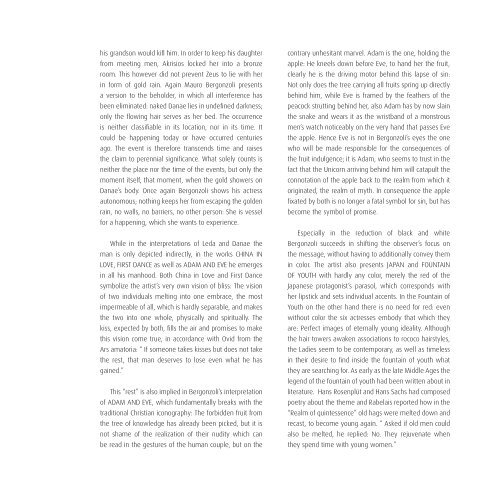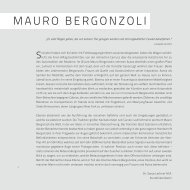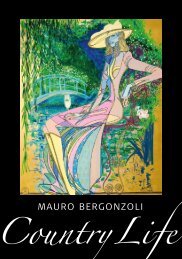Mauro Bergonzoli - Göttinnen
Mauro Bergonzoli - Göttinnen
Mauro Bergonzoli - Göttinnen
Sie wollen auch ein ePaper? Erhöhen Sie die Reichweite Ihrer Titel.
YUMPU macht aus Druck-PDFs automatisch weboptimierte ePaper, die Google liebt.
his grandson would kill him. In order to keep his daughter<br />
from meeting men, Akrisios locked her into a bronze<br />
room. This however did not prevent Zeus to lie with her<br />
in form of gold rain. Again <strong>Mauro</strong> <strong>Bergonzoli</strong> presents<br />
a version to the beholder, in which all interference has<br />
been eliminated: naked Danae lies in undefined darkness;<br />
only the flowing hair serves as her bed. The occurrence<br />
is neither classifiable in its location, nor in its time. It<br />
could be happening today or have occurred centuries<br />
ago. The event is therefore transcends time and raises<br />
the claim to perennial significance. What solely counts is<br />
neither the place nor the time of the events, but only the<br />
moment itself, that moment, when the gold showers on<br />
Danae’s body. Once again <strong>Bergonzoli</strong> shows his actress<br />
autonomous; nothing keeps her from escaping the golden<br />
rain, no walls, no barriers, no other person: She is vessel<br />
for a happening, which she wants to experience.<br />
While in the interpretations of Leda and Danae the<br />
man is only depicted indirectly, in the works CHINA IN<br />
LOVE, FIRST DANCE as well as ADAM AND EVE he emerges<br />
in all his manhood. Both China in Love and First Dance<br />
symbolize the artist’s very own vision of bliss: The vision<br />
of two individuals melting into one embrace, the most<br />
impermeable of all, which is hardly separable, and makes<br />
the two into one whole, physically and spiritually. The<br />
kiss, expected by both, fills the air and promises to make<br />
this vision come true, in accordance with Ovid from the<br />
Ars amatoria: “ If someone takes kisses but does not take<br />
the rest, that man deserves to lose even what he has<br />
gained.”<br />
This “rest” is also implied in <strong>Bergonzoli</strong>’s interpretation<br />
of ADAM AND EVE, which fundamentally breaks with the<br />
traditional Christian iconography: The forbidden fruit from<br />
the tree of knowledge has already been picked, but it is<br />
not shame of the realization of their nudity which can<br />
be read in the gestures of the human couple, but on the<br />
contrary unhesitant marvel. Adam is the one, holding the<br />
apple: He kneels down before Eve, to hand her the fruit,<br />
clearly he is the driving motor behind this lapse of sin:<br />
Not only does the tree carrying all fruits spring up directly<br />
behind him, while Eve is framed by the feathers of the<br />
peacock strutting behind her, also Adam has by now slain<br />
the snake and wears it as the wristband of a monstrous<br />
men’s watch noticeably on the very hand that passes Eve<br />
the apple. Hence Eve is not in <strong>Bergonzoli</strong>’s eyes the one<br />
who will be made responsible for the consequences of<br />
the fruit indulgence; it is Adam, who seems to trust in the<br />
fact that the Unicorn arriving behind him will catapult the<br />
connotation of the apple back to the realm from which it<br />
originated, the realm of myth. In consequence the apple<br />
fixated by both is no longer a fatal symbol for sin, but has<br />
become the symbol of promise.<br />
Especially in the reduction of black and white<br />
<strong>Bergonzoli</strong> succeeds in shifting the observer’s focus on<br />
the message, without having to additionally convey them<br />
in color. The artist also presents JAPAN and FOUNTAIN<br />
OF YOUTH with hardly any color, merely the red of the<br />
Japanese protagonist’s parasol, which corresponds with<br />
her lipstick and sets individual accents. In the Fountain of<br />
Youth on the other hand there is no need for red: even<br />
without color the six actresses embody that which they<br />
are: Perfect images of eternally young ideality. Although<br />
the hair towers awaken associations to rococo hairstyles,<br />
the Ladies seem to be contemporary, as well as timeless<br />
in their desire to find inside the fountain of youth what<br />
they are searching for. As early as the late Middle Ages the<br />
legend of the fountain of youth had been written about in<br />
literature. Hans Rosenplüt and Hans Sachs had composed<br />
poetry about the theme and Rabelais reported how in the<br />
“Realm of quintessence” old hags were melted down and<br />
recast, to become young again. “ Asked if old men could<br />
also be melted, he replied: No. They rejuvenate when<br />
they spend time with young women.”





